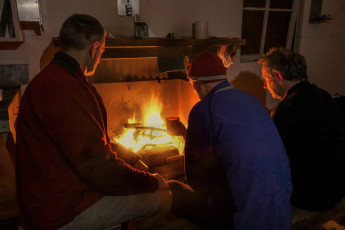
It was our fifth and last night in the Richmond Range. Robbie Burton and I had signed up to another ‘Barnett special’. Shaun knows the backcountry so well that he has a knack for conceiving excellent routes that link together many sections of tops in one continuous circuit. And the route we’d all just enjoyed was his Plan B! If the weather had behaved we would have made an attempt on Mount Murchison at Arthurs Pass, but as it transpired, the Richmond Range proved to be the right place to avoid the worst of the weather. Being September, there was still some crampon action to be enjoyed on the highest tops and, over the course of six days tramping, we didn’t meet another person.
This image - inside Mid Wairoa Hut.
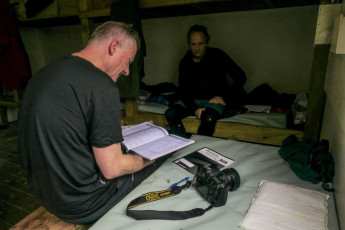
As the fire crackled and glowed, I reflected on what we’d read in the hut books during our journey. ‘More NOBOs. SOBOs. Heaps of them – at least between November and April. If we came back here in two months time we might struggle to get a seat beside the fire.’ Now that the Te Araroa Trail passes right along the Richmond Range it seems to have had a dramatic impact. Hut book entries painted a busy picture, even alluding to water shortages at times.
This image - Shaun checking out the hut book at Old Man Hut (1,100m)
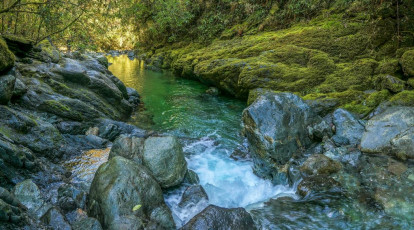
Five days earlier we began our journey, in bright sunshine, where Aniseed Valley Road meets the Hacket Track. This trail follows Hacket Creek for an hour or so to reach Hacket Hut, gaining very little altitude.
This image - Hacket Creek, at about 400m.
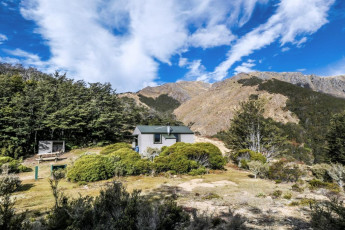
From there our climbing began. Another couple of hours saw us drenched in sweat, about 1,000m higher up, at Starveall Hut. The tree line in the Richmond Range is above 1,400m - higher than most other places in New Zealand. Starveall Hut is just under 1,200m, but it sits in a dip clear of trees, offering nice views towards Mount Starveall.
This image - Starveall Hut (1,190m), with Mt Starveall (1,511m) behind.

Shaun had been over this route before but it was all new for me. I knew that the weather was going to deteriorate, so before dinner I made a quick dash up to the summit of Starveall, a little more than 300 metres above the hut, for sunset. It’s always a pleasure to move without the burden of a heavy pack so, as the clouds reorganised themselves in preparation for rain and snow, I enjoyed photographing ridges and peaks stretching out in all directions as the sun’s last rays painted them in warm yet brooding shades.
This image - The view northwest to Waimea Inlet and the distant Arthur Range, from Mt Starveall (1,511m) at sunset.
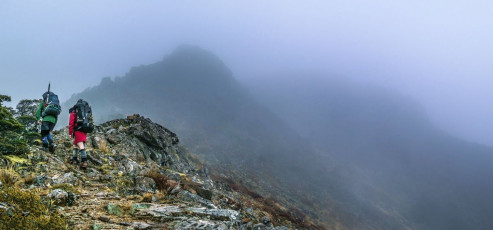
During the night rain fell, accentuating the cosiness of my sleeping bag. Next morning, the mist and drizzle outside encouraged us to get away in a leisurely manner. Depending on how the weather panned out, we would try to reach Old Man Hut, which involves a nice stretch of tops travel. But if the weather remained poor there was no point in covering that ground in clag, so we had the option to call a short day by staying at Slaty Hut, which is what happened.
This image - Heading southeast along the ridge, at about 1,250m, between Mt Starveall and Mt Slaty.
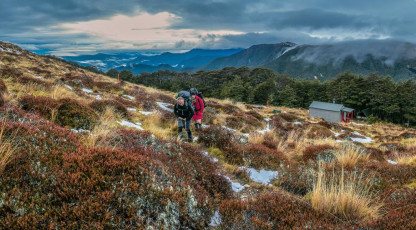
About three hours on from Starveall Hut, Slaty Hut sits right on the treeline beneath Slaty Peak 150 metres above. Unconsolidated patchy snow lay about, giving a nice alpine feel. Before sunset, I climbed up to Slaty Peak, again in the hope of some photographic action, but billowing cloud made that aspect underwhelming. Nothing for it but to hunker down beside the hut’s cast iron stove and dry our gear.
This image - Departing Slaty Hut (1,390m), early morning.
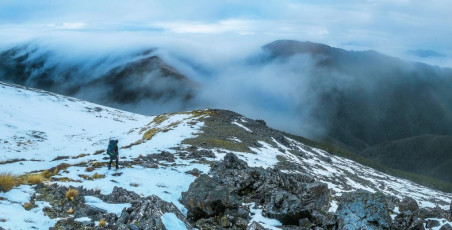
Next morning we set off again with hopes of clearer weather that would allow us to put in a fairly long day, over Mount Rintoul and down to Rintoul Hut. But we had another short-circuit option in Old Man Hut, should the weather remain clagged.
This image - Ridge top travel between Slaty Peak and Old Man.
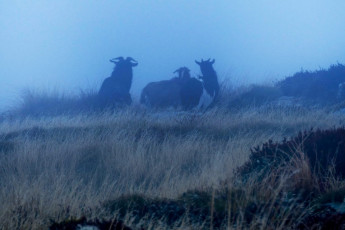
This time we were away earlier and an initial clear spell rewarded us with lovely views northeast, back along the Range. Soon though the clag was back and we plodded through swirling cloud. Sometimes a partial clearing revealed steep bluffs to our left and I regretted not being able to see the landscape in clear conditions – it looked like it would be spectacular. Our only company during the four or so hours it took to reach Old Man Hut was a small family of goats. They seemed to be enjoying the seclusion as much as us and didn’t hang about to chat.
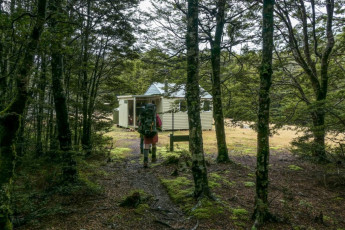
The 250 metre drop off the ridge to Old Man Hut is big enough to avoid if possible, but the weather left no doubt about calling it a day at that point. And just as well, because as we’d discover next day, the section between Old Man and Rintoul Hut offered a bigger challenge than we’d anticipated. If we’d carried on in such poor visibility it would have been dangerous.
This image - Arriving at Old Man Hut (1,100m).
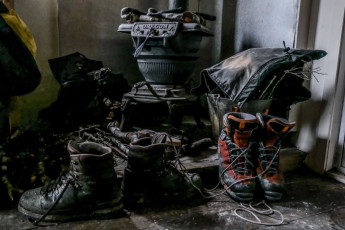
Old Man Hut sits in a clearing surrounded by dense beech forest. It’s not known for its views but the pot belly stove pumped out enough warmth to keep us chirpy. With time on hand we sought things to keep us occupied. The pyromaniac busied himself in a frenzy of wood cutting. One of the gnarled branches decided to fight back, striking Robbie in the side of the head and opening up a small gash of claret. Shaun patched him up and he was soon back on the end of the saw.
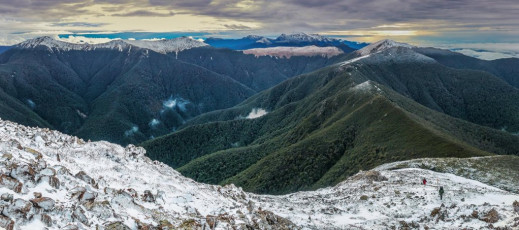
When we set off three days earlier, the forecast had indicated an improvement for day four. We had high hopes as we bided our time at Old Man Hut that evening and, sure enough, next morning dawned the clearest it had been. Mount Rintoul was the business end of the trip so we set off soon after 7am with purposeful anticipation.
It didn’t take long to regain the ridge, which led on up through beech forest. Soon the branches were weighted by snow and then we breached the tree line. A pause to don crampons and then upwards, enjoying ever more expansive vistas. There was still quite a lot of cloud about, but ridgelines and peaks were clear all around. Stretching upwards at a civilised angle was the eastern side of Little Rintoul.
This image - Looking back northeast from about 1,600m on Little Rintoul to Old Man (1,514m - right), Ada Flat and Slaty Peak (1,544m - left of centre). Mt Richmond (1,760m) and Johnston Peak (1,647m) are the snowclad peaks in the far distance (right of centre).

We reached the top of Little Rintoul two hours after setting off from Old Man Hut. At 1,643 metres it’s 88 metres lower than Mount Rintoul, but there’s a bit more to the space between the two high points than you might expect. Shaun had warned us.
This image - The top of Little Rintoul (1,643m) is far left. The dip between it and Mt Rintoul is about 300 metres lower. The summit of Mt Rintoul is 1,731m, distant right of Little Rintoul.
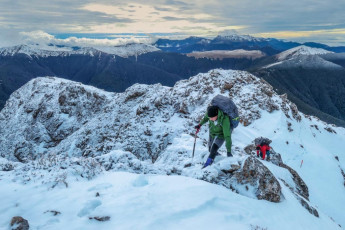
To start with, as you leave its civilised eastern aspect, Little Rintoul becomes somewhat unruly. An interesting exposed and craggy section just before you head off the west side can be deemed the crux of the route. ‘In these conditions I reckon that was Alpine Grade 1, not tramping.’ Shaun suggested after clearing a little step. Robbie and I grinned in agreement.
This image - Robbie and Shaun clearing the little notch.
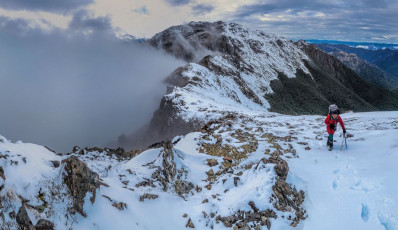
Beyond the ‘crux’ is a steep drop of over 250 metres, followed by a taxing 300 metre snow plug up the other side to the summit of Mount Rintoul (1,731m). ‘It’s classic type one fun – physical but not scary; and beautiful scenery’ I enthused between gulps of breath.
This image - At about 1,550m, looking back to Little Rintoul, from above the dip on the east side of Mt Rintoul.
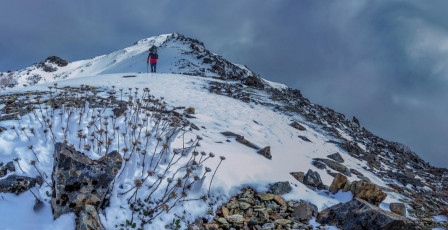
Heading to the summit of Mt Rintoul, with about 100 metres to go.
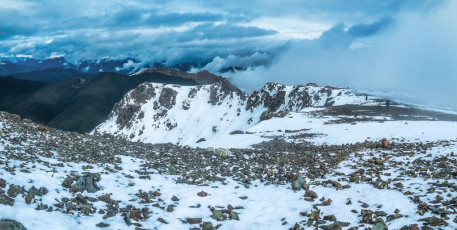
This section between high points took us two hours, so after a flurry of high fives we set off around a broad, flat horseshoe of a route to the western end of the mountain.
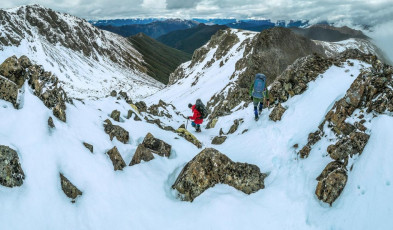
From there was another steep plunge down snow slopes, giving way to scree and then beech forest, leading down to Rintoul Hut at 1,250 metres.
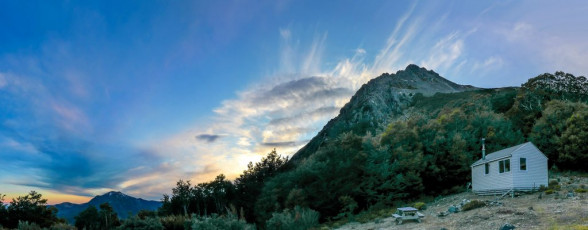
The goat family had beaten us to the hut. As we arrived they looked decidedly indignant as they thrust off into the undergrowth. ‘Bloody humans!’ A bit like Starveall Hut, Rintoul is situated in a saddle clearing. Rintoul has a view north to the Waimea Inlet, with the craggy western flanks of Mount Rintoul towering directly above. To the west, further off, sat the more mellow hump of Purple Top (1,532m), marking the high point of our route the next day. We had most of the afternoon remaining to enjoy this view, when the swirling clouds allowed. More tree-fell collecting and wood sawing was done so that we had plenty of fuel for the potbelly. In the snug warmth of the hut we discussed the Te Araroa Trail, understanding now why the eight or so day Richmond Range section is deemed by some to be the most challenging part of the entire TA.
This image - Rintoul Hut (1,250m), with the west end of Mt Rintoul above, at dawn.
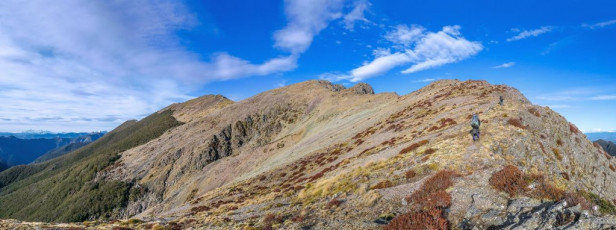
Day five dawned a bluebird, putting us in happy frames of mind for what would be our longest day. Our objective was Mid Wairoa Hut, far down in the bush beside the left branch of Wairoa River, some seven hours distant. From Rintoul Hut we climbed gradually at first through beech forest. As soon as we cleared the treeline views to the north and west unfolded, progressively improving as we made our way to Purple Top.
This image - Heading southwest to Purple Top (1,532m - centre). The further high point (1,562m) to the left is beyond the saddle leading from Purple Top to Bishops Cap. It offers even better panoramas than Purple Top. On the far left horizon lies Tapuae-o-Uenuku.

Everything from Mount Owen in the south to the Waimea Inlet in the north shone in clear morning light. To the east I was surprised to see how close we were to the inland Kaikouras, Tapuae-o-Uenuku (2,885m) and Alarm (2,877m) looking impressive.
This image - The Arthur Range, viewed from about 1,500m, near Purple Top.
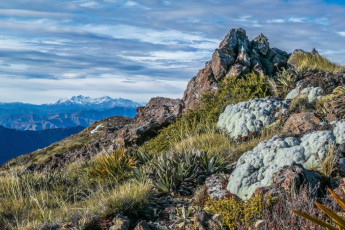
The trail over Purple Top doesn’t quite reach the highest point. There is also another a slightly higher vantage point south of Purple Top. Shaun and Robbie opted to carry on but I figured the view of Tappy up there would be even better, so dropped my pack and scampered up. I was right about the views, with a good sized herd of vegetable sheep up there making for particularly nice landscape photography.
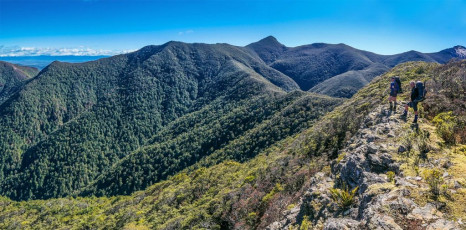
Later, as I descended into the trees on the western end of Purple Top I felt a pang of regret. It was a beautiful day and this is where our tops travel ended. I was pleasantly surprised to find several nice viewpoints as the ridge led past Bishops Cap (1,425m) and on to Tarn Hut, where we paused for lunch.
This image - Looking northeast from a clearing at about 1,300m on the ridge above Tarn Hut. Bishops Cap is right of centre and Purple Top far right.
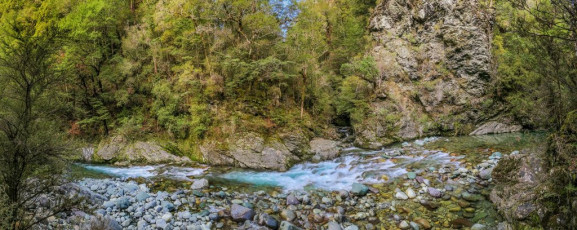
That afternoon required a bush sidle, then a 700 metre plunge down to Mid Wairoa Hut at about 360 metres. A trail leading steeply up just behind the hut is where the TA continues south, all the way over to the Wairau Valley. From where its Richmond Range section begins in the north at the end of Richmond Road, all the way over to Wairau Valley, they is no place to restock supplies en route, making this section of the TA a serious piece of multiday tramping.
This image - The Wairoa River, near where it branches left and right, just below the bench where Mid Wairoa Hut sits.
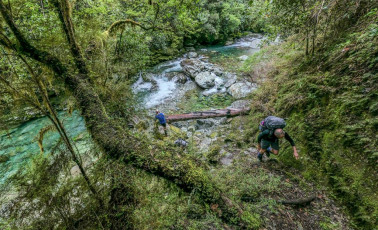
Our exit was north, tracing the left branch of Wairoa River to the Wairoa Gorge Road end. The first couple of hours scrambling up and down a steep, narrow, root infested, storm damaged trail kept us on our toes. At a tributary stream signalling the end of the rough stuff we paused to drink. ‘I reckon we found the sweet spot on this trip’ I reflected. ‘Five huts all to our selves, dramatic photography and a nice bit of cramponing up on Rintoul.’ ‘And it wouldn’t have been much fun at Arthurs Pass this week either’ replied Shaun. ‘Just awesome’ added Robbie.
This image - Beside the Wairoa River, about 2 hours north of Mid Wairoa Hut.









